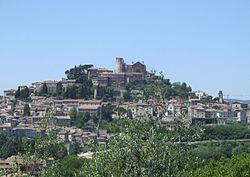Amelia, Italy
| Amelia | ||
|---|---|---|
| Comune | ||
| Città di Amelia | ||
 |
||
|
||
| Location of Amelia in Italy | ||
| Coordinates: 42°33′N 12°25′E / 42.550°N 12.417°E | ||
| Country | Italy | |
| Region | Umbria | |
| Province / Metropolitan city | Terni (TR) | |
| Frazioni | Collicello, Foce, Fornole, Macchie, Montecampano, Sambucetole, Porchiano del Monte | |
| Government | ||
| • Mayor | Laura Pernazza | |
| Area | ||
| • Total | 132 km2 (51 sq mi) | |
| Elevation | 406 m (1,332 ft) | |
| Population (1 January 2016) | ||
| • Total | 11,897 | |
| • Density | 90/km2 (230/sq mi) | |
| Demonym(s) | Amerini | |
| Time zone | CET (UTC+1) | |
| • Summer (DST) | CEST (UTC+2) | |
| Postal code | 05022 | |
| Dialing code | 0744 | |
| Patron saint | Saint Fermina | |
| Saint day | November 24 | |
| Website | Official website | |
Amelia is a town and comune of the province of Terni, in the Umbria region of central Italy. It grew up around an ancient hill fort, known to the Romans as Ameria.
The town lies in the south of Umbria, on a hill overlooking the Tiber River to the east and the Nera River to the west. The city is 8 kilometres (5.0 mi) north of Narni, 15 kilometres (9.3 mi) from Orte and approximately 93 kilometres (58 mi) from Perugia. It is about 100 kilometres (62 mi) north of Rome.
According to some scholars, Amelia is the oldest town in Umbria. It was supposedly founded by a legendary Umbrian king, King Ameroe, who gave the city the name Ameria. Cato the Elder is reported as saying that Ameria was founded 963 years before the war with Perseus (171-168 BC), so 1134 BC. This date cannot be considered accurate.
The city was later occupied by the Etruscans, and later still by the Romans, although it is not mentioned by name in the history of the Roman conquest of Umbria. Ameria occupied a strategic location in the Second Latin War (340-338 BC), lying on a loop of the Via Cassia called the Via Amerina, which started at Falerii and crossed the Tiber at Castellum Amerinum (probably Orte).
The town gained political status as a self-governing municipium, maybe as early as 338 BC, but certainly by the middle of the 1st century BC. Citizens of the town were members of the tribus Clustumina. Cicero's speech in defence of Sextus Roscius Amerinus describes Ameria as a flourishing place in 80 BC, with a fertile territory extending to the Tiber. Its fruit is often extolled by Roman writers. Augustus divided its lands among his veterans, but did not plant a colony.
...
Wikipedia


